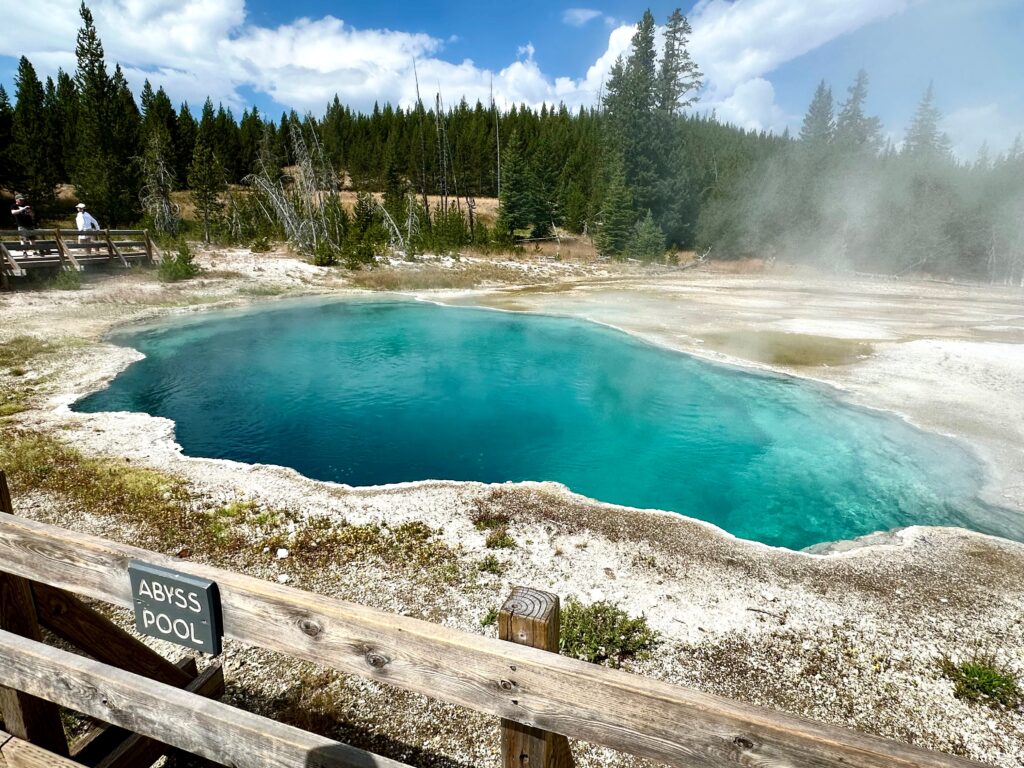
Abyss Pool in Yellowstone National Park is about 53 feet deep and contains alkaline-chloride hydrothermal fluids that in the summer of 2024 had a temperature of 181 degrees Fahrenheit. The pool has erupted on rare occasions to heights of about 100 feet. Reports in summer 2024 suggest temperatures in Abyss Pool and in nearby Black Pool are increasing. (Pat Shanks/U.S. Geological Survey)
West Thumb Geyser Basin, along the southwest shore of West Thumb Basin in western Yellowstone Lake, is one of Yellowstone’s most scenic and interesting thermal basins and contains an impressive variety of thermal features. The combination of beautiful blue, deep pools, pastel-colored mud pots, stark white sinter terraces, and expansive views of West Thumb Basin and the Absaroka Range to the east make West Thumb Geyser Basin a beautiful place to explore from the extensive boardwalk system.
The West Thumb caldera (which occupies most of West Thumb Basin) formed about 160,000 years ago as a 3.7 x 5 mile collapse caldera in response to the eruption of the rhyolitic tuff of Bluff Point. The caldera is relatively small by Yellowstone standards and is nested within the much larger 47 x 29 miles, 631,000-year-old Yellowstone Caldera. The West Thumb Caldera is similar in size to the very impressive 7,600-year-old Crater Lake Caldera, Oregon.

West Thumb Geyser Basin has active but infrequent geyser eruptions. More common are the blue, very hot (at or near the boiling point of water), and deep thermal pools and the white, extensive siliceous sinter terrace deposits that form due to overflow, evaporation, and cooling of silica-rich thermal fluids. The hot-spring pools are steep-sided inverted cones that form by dissolution of the rhyolite or sinter substrate, with enhancement by occasional hydrothermal explosions and wall collapses. At West Thumb Geyser Basin, an array of red, orange, pink, and green-colored thermophilic bacteria are common along drainage channels, on the sinter terraces, and around the peripheries of hot springs and mud pots.
Intermittent geysers at the basin include Occasional Geyser, Twin Geysers, and Lakeshore Geyser, among others. Twin Geysers and Abyss Pool produce occasional violent eruptions. Twin Geysers erupted in 1934, sending hot mud, sticks, and boiling water about 120 feet high. Abyss Pool erupts occasionally to heights of 100 feet, sometimes throwing out chunks of siliceous sinter and disrupting bacterial mats in and around the deep pool. During the summer of 2024, the temperature of Abyss Pool gradually increased, and the color turned to a spectacular shade of blue. Similar changes occurred in the late 1980s and early 1990s and were associated with explosions from the pool.

West Thumb Geyser Basin also hosts Collapse Pool, which shows evidence of collapse of the sinter rim into the pool as a result of the 1959 Hebgen Lake earthquake.
Hot springs and geysers at the geyser basin are mostly alkaline-chloride hydrothermal fluids formed by deep circulation of meteoric water (from rain and snowmelt) heated during water-rock reactions and picking up gases (mainly carbon dioxide and hydrogen sulfide) from the underlying magma chamber. West Thumb hot spring fluids have a pH range of 7.3 to 8.2 and are rich in sodium and chlorine.
In some areas at West Thumb Geyser Basin, hydrothermal fluids have boiled at depth, releasing vapor-dominated fluids (steam and dissolved carbon dioxide and hydrogen sulfide gases) and producing acid-sulfate steam vents at the surface. The sulfide gas oxidizes in the near-surface environment to produce sulfuric acid. Resulting fluids with acidic pHs of 1–3 react with sinter, rocks, and soils to produce clay-rich muds and form mud pots.
West Thumb Paint Pots is an acid-sulfate steam area with a variety of pastel-colored muds now flooded by groundwater, causing a soapy, frothy appearance. This is the largest concentration of mudpots in the basin and is related to a significant upflow zone for vapor-dominated fluids released from alkaline-chloride fluids due to degassing. There are a few other small areas of acid-sulfate mudpots in the geyser basin, and they often are near alkaline-chloride hot pools, reflecting the close association between the two styles of and chemistries of thermal features.
Extensive fields of lake-bottom hydrothermal vents occur in shallow and deep water throughout West Thumb Basin. Along the shore of West Thumb Geyser Basin and offshore by as much as 328 feet are submerged hydrothermal vents. Three of these vents have sinter cones that rise above lake level except during periods of high water. One of these is Fishing Cone, where the Hayden party first suggested the now famous “hook and cook” technique (possibly based on a “tall tale” from mountain man Jim Bridger). Members of the Hayden party caught fish with their hooks and then submerged the fish in adjacent hot water pools, thereby cooking the fish. Farther offshore, in 10 to 13 feet of water, low-temperature (59–68 degrees Fahrenheit) vents commonly are grazed by native cutthroat trout that feed on amphipods and bacteria concentrating around thermal springs.
Although it is often overlooked given the famous geysers and hot springs in other areas of the park, West Thumb Geyser Basin is one of the most spectacular due to the diversity of hydrothermal activity, dynamic nature of the thermal features, and unbeatable views of the surrounding landscape.

YOU MAKE OUR WORK POSSIBLE.

